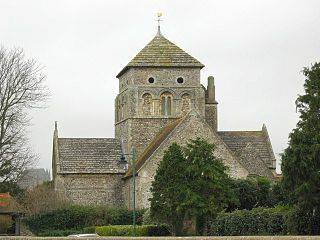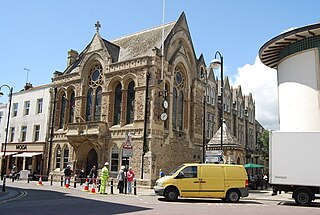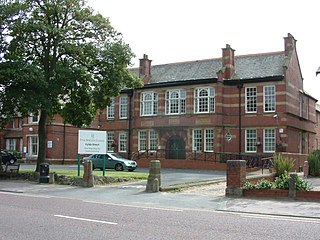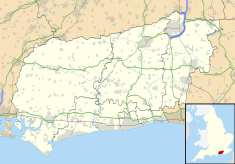
Shoreham-by-Sea is a coastal town and port in the Adur district, in the county of West Sussex, England. In 2011 it had a population of 20,547.

Lancing is a large coastal village and civil parish in the Adur district of West Sussex, England, on the western edge of the Adur Valley. It occupies part of the narrow central section of the Sussex coastal plain between smaller Sompting to the west, larger Shoreham-by-Sea to the east, and the parish of Coombes to the north. Excluding definitive suburbs it may have the largest undivided village cluster in Britain. However, its economy is commonly analysed as integral to the Brighton/Worthing/Littlehampton conurbation. Its settled area beneath the South Downs National Park covers 3.65 square miles, the majority of its land.

Adur is a local government district in West Sussex, England. It is named after the River Adur which flows through the area. The council is based in the town of Shoreham-by-Sea, and the district also contains the town of Southwick, the large village of Lancing and a modest rural hinterland inland. The district had a population of 64,626 at the 2021 census.

Southwick is a town in the Adur district of West Sussex, England located five miles (8 km) west of Brighton. It covers an area of 863.7 ha. In 2001 it had a population of 13,195.

Kingston by Sea, also known as Kingston Buci, Kingston Bucii or simply Kingston, is a small area in the Adur district of West Sussex, England. Although it is now part of a continuous urban area, its origins lay in an ancient village and parish church between Southwick to the east, Shoreham-by-Sea to the west and the mouth of the River Adur to the south. St Julian's Church survives, and its parish perpetuates the ancient "Kingston Buci" name.

Marlipins Museum, is a 12th to early-13th century Grade II* listed building on the High Street in Shoreham-by-Sea, a town in Adur district in West Sussex, England. It is distinguished by the chequerboard pattern of limestone and flint on its front façade.

Shoreham Tollbridge is a bridge crossing the River Adur in West Sussex, England. It is the last of its kind in Sussex and one of the last of its kind anywhere in the world.

St Nicolas Church is an Anglican church in Old Shoreham, an ancient inland settlement that is now part of the town of Shoreham-by-Sea in the district of Adur, one of seven local government districts in the English county of West Sussex. It was founded on a riverside site by Anglo-Saxons at the start of the 10th century, possibly on the site of a 5th-century predecessor. Some Saxon-era structural elements remain despite 12th-century additions made when Shoreham became prosperous, further extension in the 14th century and a Victorian restoration. The cruciform structure, with its solid central tower, features some unusual Norman-era carving. English Heritage has listed it at Grade I for its architectural and historical importance.

The name St Peter's Church has been borne by two Roman Catholic churches in the town of Shoreham-by-Sea in the district of Adur, in the English county of West Sussex. The original church with that dedication was the town's first permanent Roman Catholic place of worship; founded in 1875, it was paid for by Augusta, Duchess of Norfolk, a member of the most important Dukedom in England. After its closure, a new St Peter's Church was built nearby. The old building, which still stands and is in residential use, has been listed by English Heritage at Grade II for its architectural and historical importance.
The district of Adur, one of seven local government districts in the English county of West Sussex, has 119 buildings with listed status. The urbanised southern part of the district forms part of the Brighton/Worthing/Littlehampton conurbation, and most listed structures are in the three main centres of population: Southwick, Shoreham-by-Sea and Lancing. The towns have grown residentially and industrially in the 20th century, but all three have ancient origins as villages and manors on the banks of the River Adur and the English Channel coast. The rest of Adur district's territory is remote downland countryside with scattered farms and hamlets; some of their buildings also have listed status.

The Red Lion Inn is a 16th-century public house in the ancient Old Shoreham part of the town of Shoreham-by-Sea, in the Adur district of West Sussex, England. Established in the 16th century in part of a former monastery and cottage in the centre of Old Shoreham, opposite the village's former tollbridge, it was extended in the 19th century and became central to life in the old village. Alfred, Lord Tennyson's poem Rizpah is based on events at the inn in the 19th century which resulted in the capture and execution of some robbers. English Heritage has listed the building at Grade II for its architectural and historical importance.

Worthing Town Hall, or New Town Hall, is a municipal building in Chapel Road, Worthing, West Sussex, England. The town hall, which is a meeting place of Worthing Borough Council, is a Grade II listed building. Located at Chapel Road in the centre of Worthing, it was opened in 1933 and built in a neo-Georgian style to designs by Charles Cowles-Voysey. Containing offices and a Council chamber it replaced Worthing's Old Town Hall as the administrative centre, a building that had been the home of Worthing's local authority from 1835 and was demolished in 1966. To the rear and west lies the Assembly Hall, built in 1935, also to designs by Cowles-Voysey. To the south lies the Worthing Museum and Art Gallery, originally built as a Carnegie Library.

Hastings Town Hall is a municipal building in Queen's Road, Hastings, East Sussex, England. The town hall, which was the meeting place of Hastings Borough Council, is a Grade II listed building.

Bexhill Town Hall is a municipal building in the London Road, Bexhill-on-Sea, East Sussex, England. The town hall, which is the headquarters of Rother District Council, is a Grade II listed building.

St Annes's Public Offices is a municipal building in Clifton Drive, St Anne's-on-the-Sea, Lancashire, England. The building, which was the headquarters of St Anne's-on-the-Sea Urban District Council, is Grade II listed.

Hitchin Town Hall is a municipal structure in Brand Street, Hitchin, Hertfordshire, England. The town hall, which was the headquarters of Hitchin Urban District Council, is a Grade II listed building.

The Municipal Buildings are located on the north side of High East Street in Dorchester, Dorset, England. The structure, which was the headquarters of Dorchester Borough Council, is a Grade II* listed building.

Portslade Town Hall is a municipal building in Victoria Road in Portslade, East Sussex, England. The structure, which was the meeting place of Portslade Urban District Council Council, is a locally-listed building.

The Old Town Hall, is a former municipal building in Albion Street in Southwick, West Sussex, England. The building, which is now used as offices, was the meeting place of Southwick Urban District Council.



















